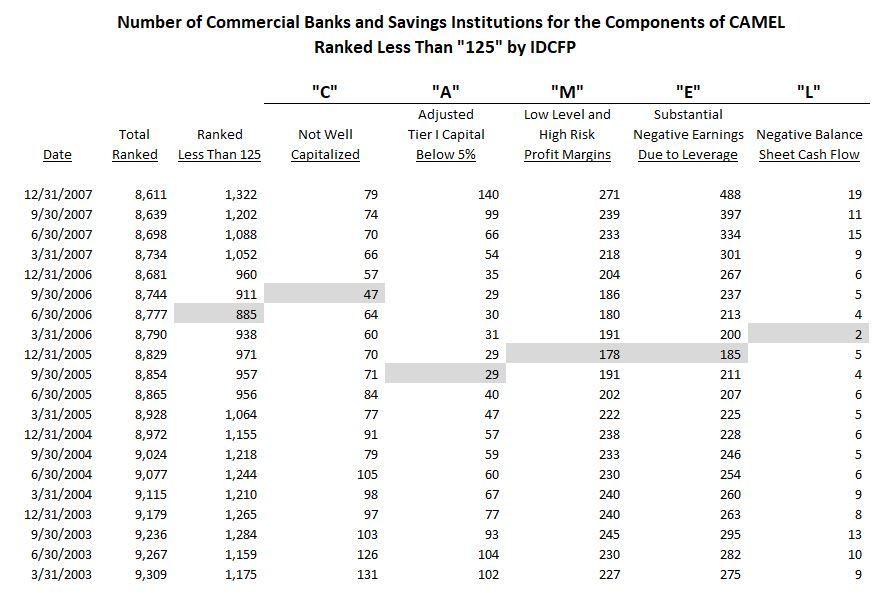A Potential Banking Crisis in 2020 or 2021
Component “E” of IDCFP’s CAMEL, Which Forecast the 2008 Economic Crisis in Banking as Early as 2005, Indicates a Potential Banking Crisis in 2020 or 2021
This article on “The Early Warning Signal of a Potential Banking Crisis” summarizes the components of CAMEL as a forecast of the next banking crisis.
At the low risk point in the banking cycle, the number of banks and savings institutions ranked less than “125” or investment grade reached its lowest level of 447 in the 3rd quarter data of 2017, driven by the low count of 146 banks in the component “E”, or earnings from financial leverage in September 2017 (see Table I).
Brokers of CDs and investors in CDs, as well as insurance companies, federal agencies, state governments, interbank lending, and a host of other institutions rely on IDCFP ratings of commercial banks and savings institutions to make better decisions using its unique and proprietary CAMEL methodology.
Earnings Returns - - The “E” in CAMEL Forecasts A Potential Banking Crisis in 2020 or 2021 (see Table I)
The separation of Earnings in ROE between Earnings from ROEA and ROFL provides insight into management’s operating and financial success or lack thereof.
ROEA is defined income from operations before funding costs (income from loans, investments and non-interest income, less operating expenses and applicable taxes and the change in the loan loss reserve, as a percent of earning assets) to reflect operation of a bank or savings institution, as if equity and loan loss reserves were total liabilities and capital.
ROFL is defined as income from financial operations. It reflects the degree to which a bank or savings institution uses deposits and debt to finance its earning assets or operating strategy based on the after-tax cost of these deposit and debt funds. ROFL consists of leverage spread (return on earning assets less cost of adjusted deposits and debt, both after-tax) times the leverage multiplier (the ratio of adjusted debt to equity plus the loan loss reserve). Adjusted debt equals earning assets (before the loan loss reserve) less equity capital and loan loss reserves.
The risk in a bank or savings institution is a negative ROE, which destroys equity capital. The risk is amplified, however, to the institution’s safety and soundness, when ROFL is negative. The operating earnings ratio (ROEA) is low or negative and the cost of adjusted deposits and debt exceeds ROEA, causing a negative leverage spread, and then, times financial leverage, creates an even greater loss, as reflected in ROFL. Currently, a negative ROFL has been exhibited in small banks. As the Federal Reserve raises the fed funds rate by 1% to 1.5% in the next two years, the low levels of operating returns (if not corrected) with rising costs of funding, create continuous future losses in net income for these 173 firms and, potentially, more financial institutions. Given Reported and Continuing Future Losses, Recent Tax Reductions Fail to Assist These Institutions.
IDC Financial Publishing, Inc. is Your Early Warning System of a Future Financial Crisis.
The “E” Component of CAMEL, as Well as, the Total of Banks Ranked Less than “125”, Indicates Risk from our Early Warning System of a Future Financial Crisis in 2020 or 2021
The low risk level in the 146 banks and savings institutions, ranked less than “125” in “E” in the 3rd quarter 2017, caused a low for all institutions ranked less than “125” of 447 in the 3rd quarter of 2017 (see Table I).
Table I

Commercial Banks and Savings Institutions with ROE less than COE and Negative Return on Financial Leverage (ROFL) are so Deficient in Profitability to Receive an IDCFP Rank Below “125” (300 the Highest and 1 the Lowest). Additional Components of CAMEL, however, are Required to Increase in the Count of Banks Under “125” in other CAMEL Components to Confidently Forecast the Severity of the Potential Banking Crisis.
Early Warning Indicators in 2005 and 2006 (see Table II)
The low in the number of commercial banks and savings institutions ranked below the industry standard as investment grade “125” occurred in the 2nd quarter of 2006, two years before the banking crisis in 2008. Most important, however, is that all but 1 of the 5 components of CAMEL reached a low in their number of institutions from the 3rd quarter of 2005 through the 1st quarter of 2006 – prior to the low count for all institutions ranked less than “125” in the 2nd quarter of 2006.
As seen in Table II below, commercial banks and savings institutions not well capitalized (“C” in CAMEL) reached a low of 47 in the 3rd quarter of 2006. Financial institutions measuring adequacy of capital with adjusted Tier 1 capital below 5% (Tier 1 capital adjusted for bad and delinquent loans net of the loan loss reserve), the “A” in CAMEL, reached a low count of 29 in the 3rd quarter of 2005. Banks and savings institutions with a lack of profitability or low and unstable margins, the “M” in CAMEL, reached a low of 178 in the 4###sup/sup### quarter of 2005. The commercial banks and savings institutions with severe negative “Earnings due to Leverage” (the “E” in CAMEL) reached their low of 185 in the 4###sup/sup### quarter of 2005, two quarters before the total number of institutions ranked below “125” reached its low in the 2nd quarter of 2006. Finally, institutions with high loan delinquency and negative balance sheet cash flow – the “L” in CAMEL – reached their low of 2 in the 1st quarter of 2006.
Table II
Components of CAMEL Forecast Banking Crisis in 2005, up to Three Quarters Before the Total Ranked Below “125” in June of 2006

IDCFP has been helping CD brokers and investors, insurance companies, federal agencies, numerous state governments and a host of other institutions make better decisions using its unique and proprietary CAMEL rating methodology since 1985. For more information on CAMEL go to www.idcfp.com or call 1-800-525-5475.

